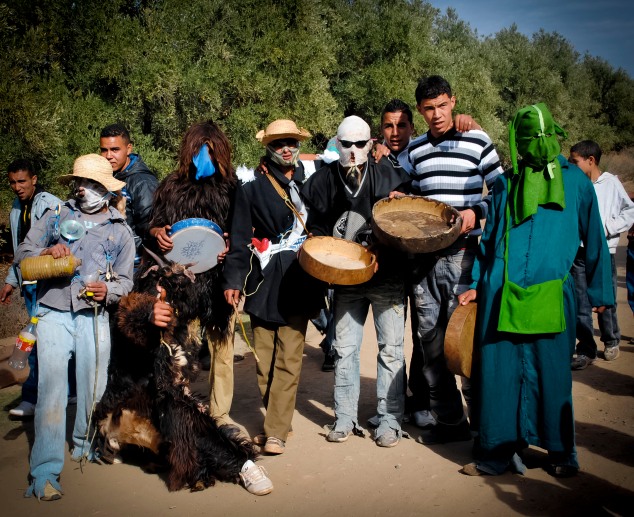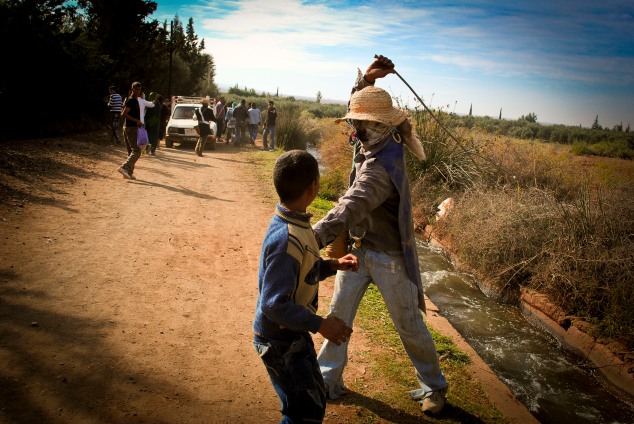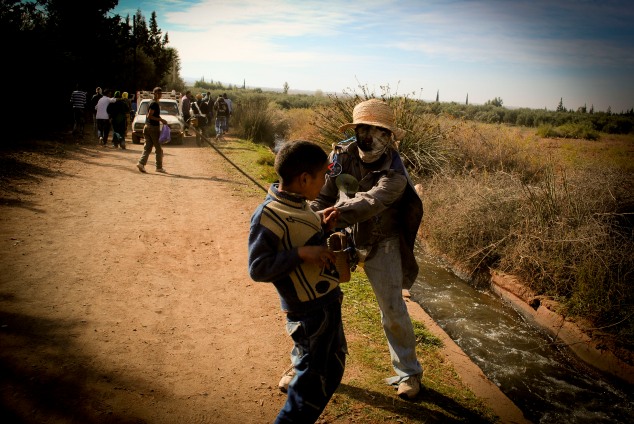Eva Longoria is no stranger to attention, no shrinking violet. I do not even know who she is, and yet I know who she is. Maybe because her perfect bronzed effigy looms over me at the supermarket, singing a siren song of miracle dream creams, secret potion lotions from the Oracle of L’Oreal?
(Thank you, but I think that for me to look anything like the image on that poster, scientists would have to splice actual L’Oreal genes straight into my DNA. After that, I’d have to morph into a body that is 10 feet tall and 6 inches wide. I’ll pass.)
So when Eva showed up on the side of the road outside of Marrakesh, well it’s no surprise that her presence caused a bit of a stir.

Imagine you are driving through peaceful Berber country, passing mud villages, olive orchards, and farmers harvesting their year’s supply of wheat. Men and women’s voices rise through the sleepy sunlit air, singing traditional harvest songs, sheep roam in search of shreds of pasturage, an old man in a jellaba rides by on a donkey. Nothing could mar this bucolic serenity.
Then, all of a sudden, why it’s Giant Eva Longoria. Weird.
Wait, there she is again.
Oh, it’s just some kind of real estate thing. Bah! Gentrification! I turn my nose up at you.
No, you’re kidding me, I’ve been driving for 20 minutes, and I see ten billboards of Eva? Because I missed the first nine. But the tenth one really drove it home. Why if this condo development is good enough for Eva, then what are we all waiting for? Hurry up good people, and sign on the dotted line, because there are only 1,000 apartments and 400 villas left, and they’re going fast. (I googled it, those numbers are factual. So if you’ve ever wondered what it would be like to live in a beehive, give it a whirl).
Am I the only one who finds these adds in poor taste? Folks, it’s plain old cultural insensitivity. Berber culture is very traditional. Cleavage, as shown in the photo, is considered a private part of the body. Ok, I realize that for most of my western readers, and even my Moroccan urban dwelling readers, this photo is very tame, it’s ho-hum in our flesh-image saturated world. Female bodies remain the go-to advertising commodity, with less and less left to the imagination. (In fact, these same adds, along with the rest of the ladies from Desperate Housewives, are plastered all over Casablanca, and they don’t seem to have caused any ripples.)
But try to look at it from an Other perspective. Imagine your eyes have not yet filled with such imagery. Imagine that someone put up a giant billboard in your neighborhood, showing body parts that you consider private. How would you react?

Would you, say, sneak out in the middle of the night with a can of black paint and go on a crazy daredevil mission demonstrating your community’s protest against said billboard? Because that’s what someone did to Eva. All ten of her.
And if you are the advertising mastermind behind the Eva adds, would you get the point, and go with something a little more culturally appropriate? Or would you photoshop 2 inches more tank top onto Eva’s cleavage, and pay for another 10 slightly more covered Evas to be re-plastered onto said billboards? Because that’s what someone did. Improbable, but true.

(You can see the next billboard not too far off).
So everyone is happy, right? The advertisers still get to associate their condos with glamorous, glorious Eva, and the locals can stop making such a fuss now that her shirt is hiked a few millimeters in the front. End of story?
Wrong, this was just the first battle in the war that was waged between these two parties, whom I’ll call Ad Machine and Billboard Bandits.
The Billboard Bandits strike again. No paint this time, but the billboards are in tatters when they are done.
Next move by Add Machine: a new add featuring a somewhat bizarre looking couple, meant to be Moroccan, each looking in the opposite direction. (subtext: these condos are for couples that are drifting apart?)
Billboard Bandits, it’s your move. Sure enough, the adds are again shredded. Methinks this is no longer about cleavage.
Last attempt by Add Machine, this time they go with the most benign and forgettable add possible. So forgettable that I can’t even remember it, see? I think it’s a photo of a balcony, with of course, the snow-capped Atlas rising majestic in the background.
Soon I will take that drive once more and see if this last billboard has survived. I can’t stand the suspense, can you?
But first, lets take a moment to analyze these events. Because it would be wrong to think that this issue is just about showing the human body in ways that the local population finds degrading to women. Certainly that is a mistake on the part of the advertisers, who should not use the same concept on a dusty country road as in the heart of a worldly metropolis. However, I believe that the thorn runs deeper than that. It’s the juxtaposition of two completely different realities that is so unsettling. On the one hand, we have this world of image and fantasy, of unimaginable riches and luxuries, of ersatz culture that attempts to package and commodify the Moroccan experience with no soul whatsoever. All of it a vacuous Orientalist version of a Morocco pandering to the every whim of the upper crust. A vision of Morocco that would not hesitate, for example, to introduce alcohol to a valley that has been dry forever, with no thought given to how it might destroy the lives of the locals.
On the other hand, we have the traditional lives of the Moroccan Berbers. Berber families that are still connected to the natural cycles in the most primordial of ways. Whose actions and intentions stem from a deep faith in God, enjoying the contentment that ensues. Whose meals are bread from their own land, olive oil from their own trees, served in clay dishes from the Ourika river, sitting on rag rugs they’ve made with their own hands from scraps of old clothes. There is nothing more real, beautiful, spiritual, sustainable. They, and all the traditional peoples of the world, are the original “organic, local and slow” ways that we crave and long to return to.
So Eva Longoria et al, you are more than welcome in this old and beautiful world, but on its terms, not yours. If your goal is to use and plunder, then you will be met with resistance. Bring with you the best of what your culture has to offer the world. Then take the time to learn about Morocco, its beautiful people, its old ways that are still alive under the strain of globalization. Peace and grace are yours for the finding.












































